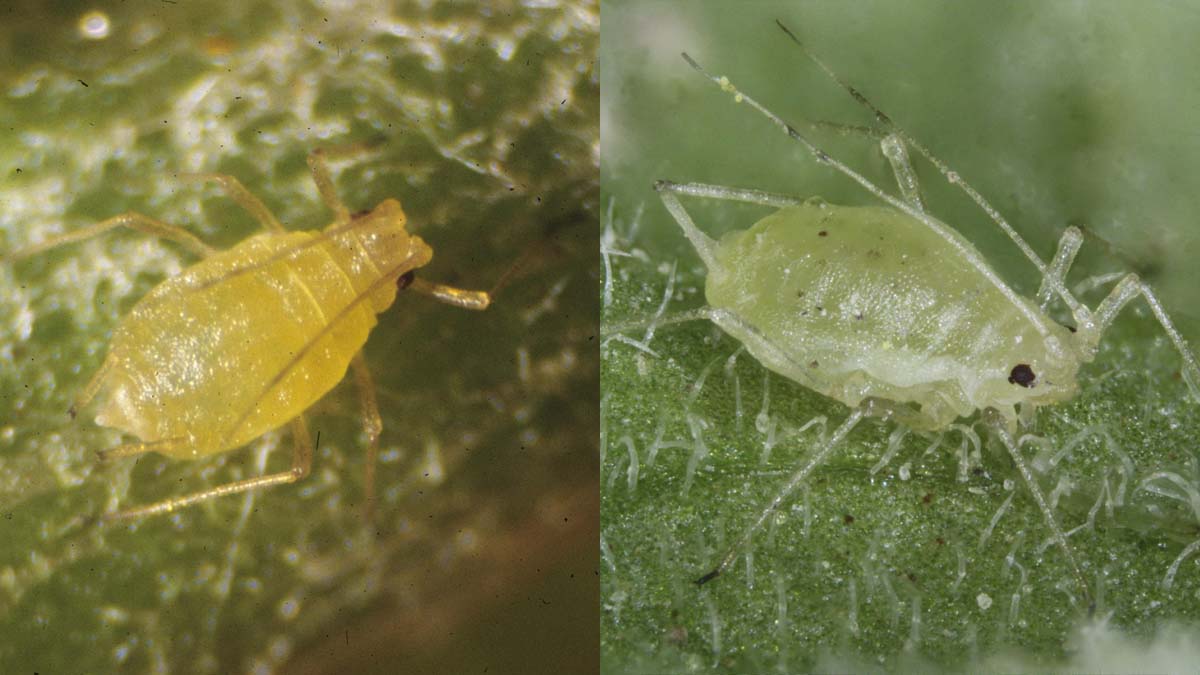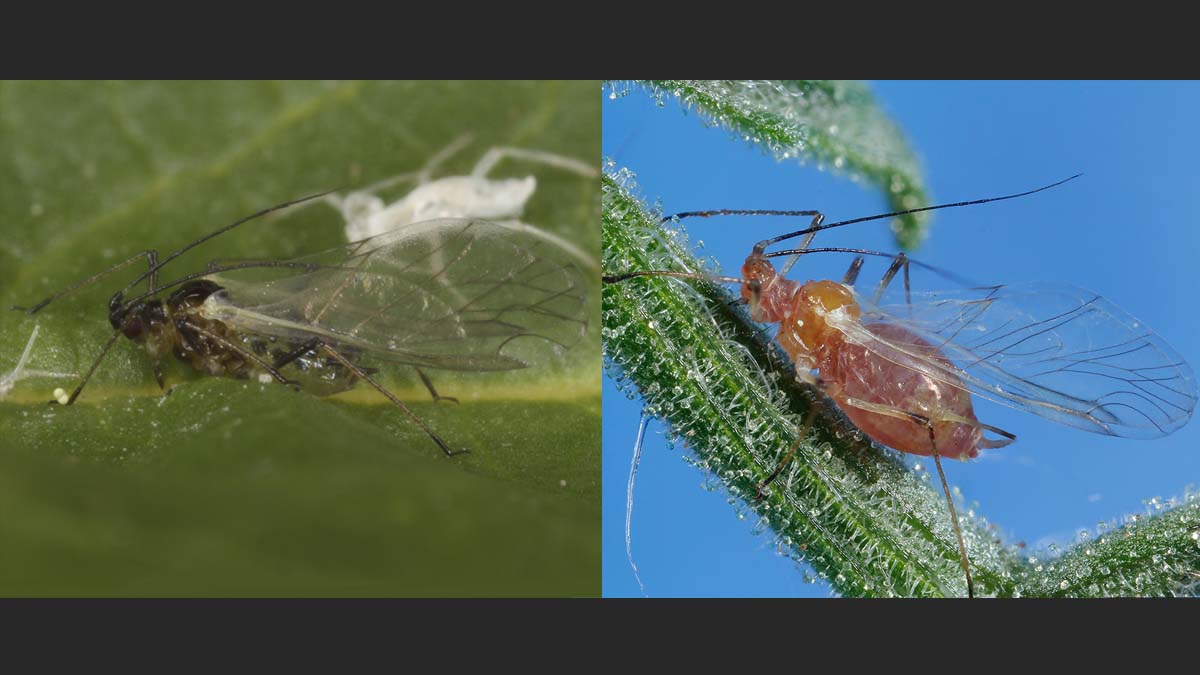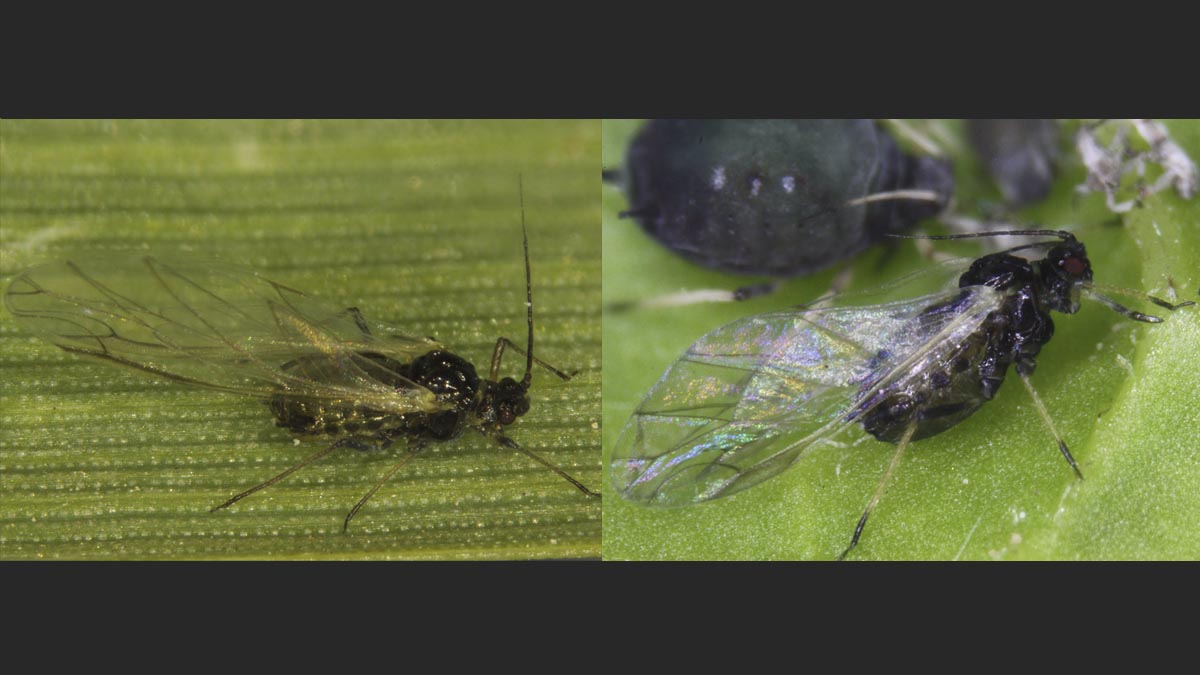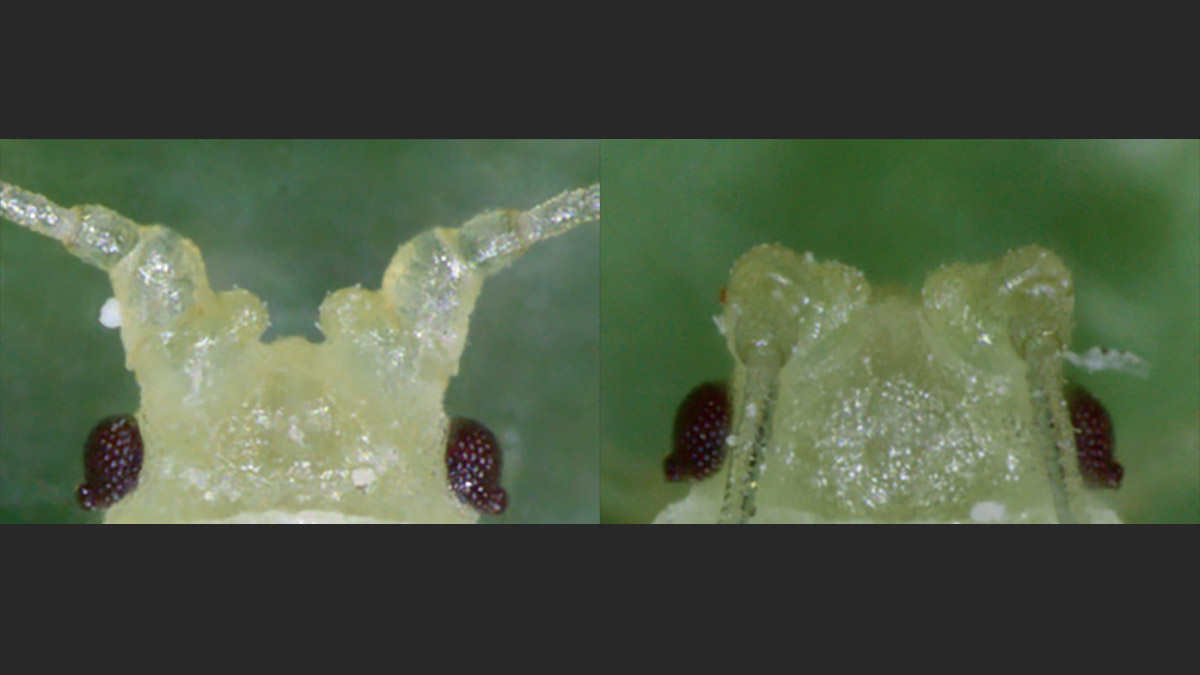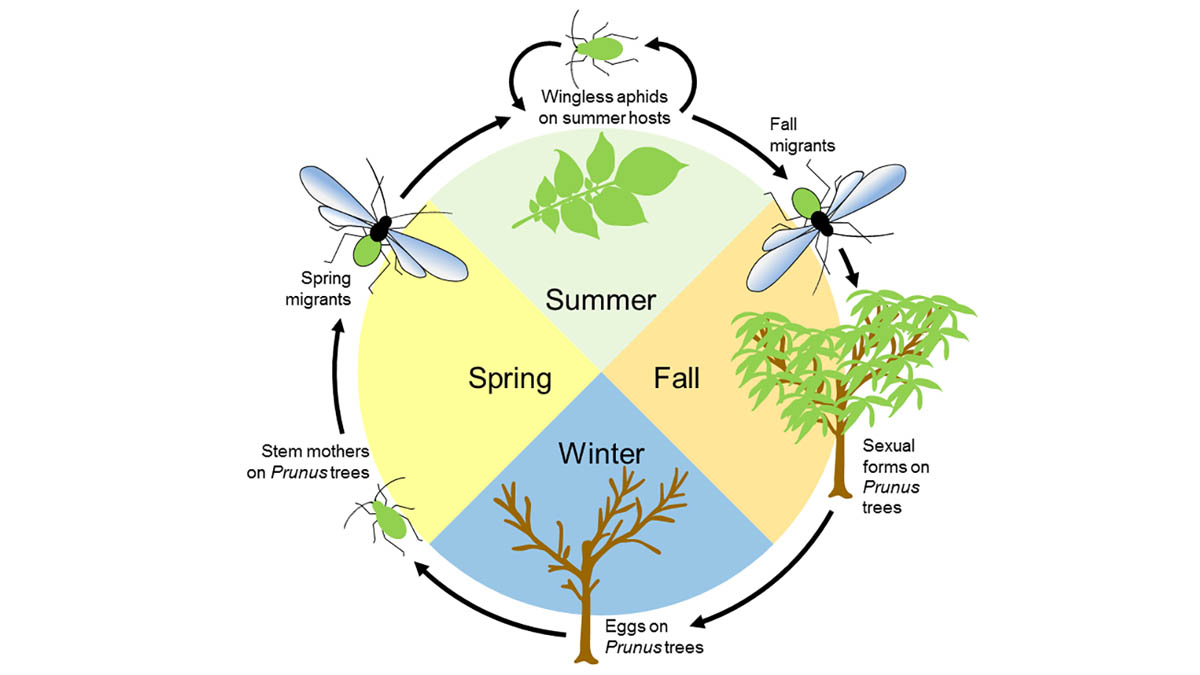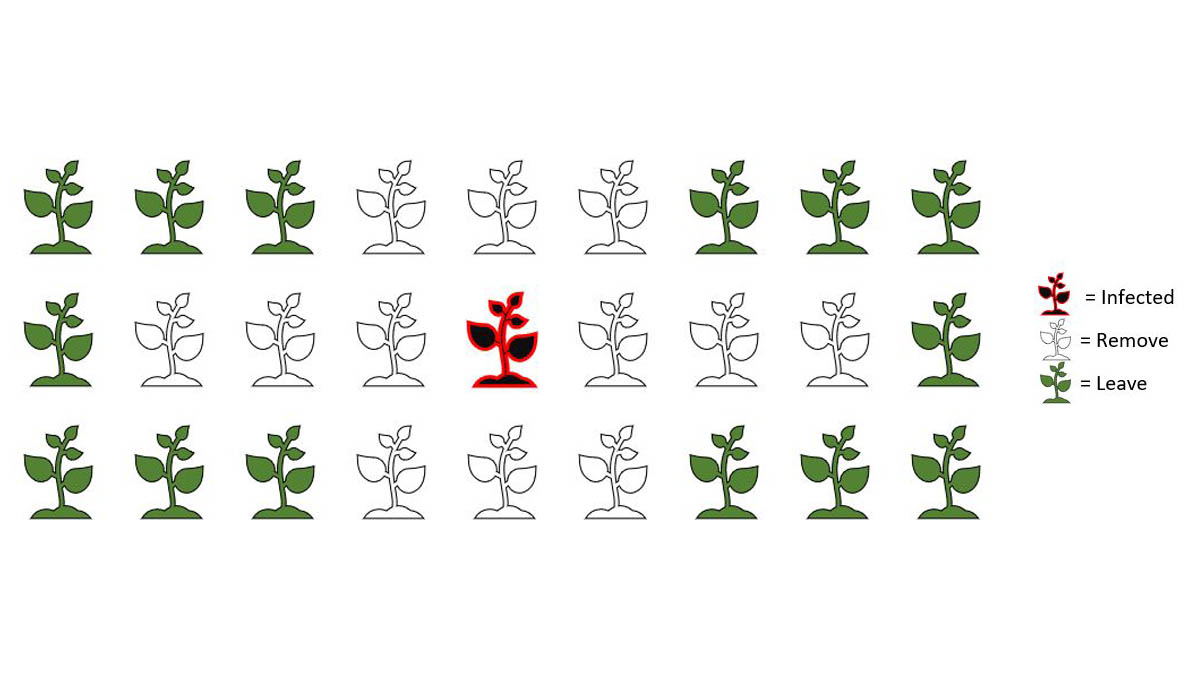Aphids
Pest Common Name
- Green Peach Aphid (Myzus persicae)
- Potato Aphid (Macrosiphum euphorbiae)
- Non-potato-colonizing aphid species, including dozens of others that can damage potato by vectoring virus
Green peach aphids
- Potato
- Other crops: barley, corn, oats, sugar beet, wheat, oilseed rape, others
- Fruits and vegetables: plum, peach, nectarine, pepper, squash, tomato, others
- Weeds: shepherd’s purse, medic, field bindweed, hairy nightshade, many others
- Host range includes more than 40 plant families
- Primary, winter host: Prunus spp., including peach, plum, others
Potato aphids
- Potato
- Other crops: legumes, oats, sugar beet, others
- Fruits and vegetables: apple, peas, beans, pepper, tomato, others
- Weeds: nightshades, ragweed, common lambsquarters, pigweed, shepherd’s purse, others
- Host range includes more than 20 plant families
- Primary, winter host: rose (Rosa spp.)
Non-potato-colonizing aphids
- Feed on a diversity of hosts and only transiently visit potato
Aphids are small, soft-bodied, pear-shaped insects with piercing/sucking mouthparts. Adult aphids can be either wingless (Figure 1) or winged (Figure 2), whereas nymphs are always wingless. Aphids have cornicles, small rear-facing “tailpipe” like appendages near the end of the abdomen, a key trait in distinguishing them from other small arthropods.
A winged aphid found in a potato field might be a potato colonizing species (Figure 2) or one of dozens of non-potato colonizing species (Figure 3) that may transiently visit potato fields after dispersing from a different host plant. Though non-potato colonizing aphids do not feed and reproduce on potato, they may transmit virus while “taste-testing” the leaves. An aphid specimen is very difficult to identify to species without knowing the host plant it came from, making identification of these transient visitors to potato fields very challenging.
On the other hand, wingless aphids found feeding on potato in Idaho are almost certainly one of two species: green peach aphid (Myzus persicae) or potato aphid (Macrosiphum euphorbiae) (Figure 1). The adults (both winged and wingless) of green peach aphid are about 3/32 in (2.5 mm) long and green. The winged form has a large dark patch on the back and a black head and thorax (Figure 2), whereas the wingless form does not. The immature forms, called nymphs, can range from pale green or yellow to pinkish red. Infestations of green peach aphid usually begin on the bottommost leaves of potato plants.
Potato aphids can be either pink or green. Potato aphids are usually larger than green peach aphids, about 9/64 inch (3.5mm) long. Infestations of potato aphid are usually scattered at all levels of the plant.
When wingless aphids are found on potato, the best way to differentiate between these two species is to look at the tubercles at the base of the antennae. These “bumps” between the antennae converge on the green peach aphid, whereas they tend to diverge on the potato aphid (Figure 4).




Biology
Aphids feed on plants by piercing plant tissues and sucking out nutrient-rich fluids. Some aphids feed on only a single plant species, whereas other can feed on a wide variety of plants. Many aphid species, including green peach aphid and potato aphid, have complex life cycles that include the use different hosts in the winter versus the summer. Green peach aphids overwinter as eggs on trees in the genus Prunus (peach, plum, others) while potato aphid overwinter as eggs on rose plants (Rosa spp.). In the spring, female aphids emerge from these eggs. These females, known as stem mothers, give live birth to nymphs (clones) without ever mating. As summer approaches, winged females (spring migrants) develop and move from winter hosts to their summer hosts. Summer hosts include potato and many other species of plant. Many overlapping generations of wingless individuals are then produced on these summer hosts. During the summer, if aphid populations become too dense or host plant nutrition declines, winged individuals may develop and disperse. During late summer and early fall when temperatures drop and summer hosts begin to die, winged migrants again develop. These fall migrants fly to winter hosts where males and females mate, and females lay eggs that will overwinter to start the cycle anew the next spring (Figure 5).

For non-potato-colonizing species, spring migrants or other winged adults may pass through potato fields as they seek a proper host. These migrants will probe plants to assess host suitability. This probing alone is not particularly damaging, but virus may be transmitted in the process (discussed in “Damage” below). Thus, this element of non-colonizing species’ biology is important to understand.
Damage
Though severe infestations of aphids can weaken plants, aphids are primarily of concern in potato because they spread pathogens that cause disease. Both green peach aphid and potato aphid are vectors of two important diseases in potato, Potato virus Y (PVY) and Potato leafroll virus (PLRV). Green peach aphid is the more efficient transmitter of both viruses.
PVY can be transmitted by aphid vectors or can occur in a plant grown from an infected tuber. PVY can reduce potato yield and quality and hinder certification of seed potato. Certain strains of the virus can also cause Potato Tuber Necrotic Ringspot Disease (PTNRD), which may manifest as rough rings of red or brown skin and necrosis of the tuber flesh beneath these areas of skin discoloration (Figure 6). Although PVY is transmitted very efficiently green peach aphid, PVY is also transmitted by many species of non-potato-colonizing aphids that may transiently visit potato. Despite lower PVY transmission efficiency, several such species can be considerably more abundant than either of the potato-colonizing species. This makes the non-colonizing species much more important to PVY epidemiology. Moreover, the speed at which PVY can be transmitted (seconds to minutes) makes this disease particularly difficult to manage given that insecticides cannot kill aphids this quickly.

PLRV can also be transmitted by aphid vectors or can occur in a plant grown from an infected tuber. PLRV transmitted by aphid vectors tends to cause symptoms in new leaves, leading them to develop chlorosis and causing the edges to roll upwards. Plants grown from infected tubers are more severely affected, being generally stunted, and have leaf symptoms such as leathery texture, premature death, and rolling of the lower leaves. PLRV causes a necrotic netting pattern in the vascular tissue of tubers of some varieties. PLRV is not transmitted by non-potato-colonizing aphid species. Currently, PLRV is effectively controlled by neonicotinoid insecticides, but there are concerns that resistance could be developing, or that these insecticides could be restricted or banned.
Monitoring
Suction traps are widely used to monitor flying insects, including aphids. Typically, these traps consist of an open-topped vertical tube, at least 6 feet (2 m) in height, with a fan pulling air through the tube. Flying insects are pulled into a collection container which usually contains a mixture of ethanol and propylene glycol. These traps monitor aphid movement, more than aphid populations in a particular field, and are often maintained in networks by governmental agencies or universities. For University of Idaho’s aphid monitoring data, visit the Idaho Pest Monitoring site.
Leaf sampling is a straightforward way to monitor densities of colonizing aphids in a field. Monitoring of fields should begin early in the season and can be concentrated around field margins where colonizing is likely to begin. Areas downwind of nearby Prunus trees and weedy areas should be a primary focus of scouting efforts. In seed fields, monitoring should occur once or twice per week, beginning at emergence and extending through the end of the season. A minimum of 50 leaves should be sampled. Since green peach aphid tends to concentrate in the lower third of the plant, some sampled leaves should come from this part of the plant. However, potato aphids may be found on any leaves, so monitoring middle and upper leaves is also prudent. Wingless aphids may be identified using a hand lens.
Economic thresholds for aphids in potatoes are not well established in Idaho and can vary greatly. Depending on the type of potato production (seed versus commercial), region, variety and pathogens of concern, anywhere from more than zero to about 10 aphids per 50 leaves might justify insecticide treatment.
Management
Primary Management Tactics
Though potato-colonizing aphid species have the potential to pose significant threats to potato production, today they are generally managed successfully using chemical tactics in commercial production. Thus, non-potato-colonizing aphids are of primary concern in managing aphid-vectored potato diseases such as PVY, especially in seed fields. Chemical treatments cannot stop aphids from moving into a field but may reduce population development and limit the spread of potato-colonizing species within a field. Conserving natural enemies and avoiding excess nitrogen through proper fertilization can contribute to limiting population growth of colonizing species. Planting certified seed with little or no PVY incidence is also a cornerstone of PVY management, especially in seed potato. Planting resistant cultivars and removing and destroying infected plants immediately can further help reduce virus prevalence.
Physical
- Plant only clean, certified seed
- Keep crop and surrounding areas free of weeds
- Remove dead and diseased plants as quickly as possible, and for maximum effectiveness also remove three plants to either side of the infected plant in the same row, as well as the three plants nearest the infected plant in the two adjacent rows (Figure 7)

Cultural
Remove or treat potential sources of aphids:
- Unmanaged Prunus fruit trees can serve as winter hosts to green peach aphids; removing or treating with mineral crop oils and/or insecticides can reduce populations
- Nursery plants and home gardens can be source of vector aphids and viruses, and allow for the survival of green peach aphid’s winter hosts (Prunus fruit trees) in regions that might otherwise be too cold
- Weeds should be managed both in-season and off-season
- Volunteer potatoes and weeds in the nightshade family can host both potato-colonizing aphid species and potato viruses and should be removed
- Other crops (including cereals, corn, alfalfa and sugar beet) can host high populations of non-potato-colonizing aphids which can then disperse to potatoes and transmit PVY; management of aphids in these crops should reduce vector prevalence in nearby potato
- Consider managing aphids in early maturing varieties to avoid spread of aphids and virus to late-season varieties
Consider virus-resistant varieties:
- Note: These cultivars show fewer symptoms of disease, which is ideal for commercial or home growth, but may make disease monitoring difficult when growing for seed
- Avoid excess nitrogen by following fertilization recommendations
Biological
- To encourage populations of natural enemies, including predators, parasitoids and insect-killing fungi, avoid using broad spectrum pesticides and keep in mind that fungicides applied against foliar diseases (e.g., late blight) kill beneficial fungi
- Economic thresholds for aphids are very low in seed potato, so natural enemies alone are often not sufficient
Chemical
- Systemic insecticides applied at planting can control aphids for several weeks, and when there is little mid- to late-season aphid pressure this single application at planting may be sufficient
- Foliar insecticides may be necessary to manage mid-season outbreaks
- Consider adding mineral oil applications to your insecticide program to achieve greater control
Further reading
Pesticide Warning
Always read and follow the instructions printed on the pesticide label. The pesticide recommendations in this University of Idaho webpage do not substitute for instructions on the label. Pesticide laws and labels change frequently and may have changed since this publication was written. Some pesticides may have been withdrawn or had certain uses prohibited. Use pesticides with care. Do not use a pesticide unless the specific plant, animal or other application site is specifically listed on the label. Store pesticides in their original containers and keep them out of the reach of children, pets and livestock.
Trade Names — To simplify information, trade names have been used. No endorsement of named products is intended nor is criticism implied of similar products not mentioned.
Groundwater — To protect groundwater, when there is a choice of pesticides, the applicator should use the product least likely to leach.
- Figure 1 (left). Jim Baker, North Carolina State University, Bugwood.org
- Figures 1 (right) & 2 (left) & 3-6. Erik J. Wenninger, University of Idaho
- Figure 2 (right). Joseph Berger, Bugwood.org
- Figure 7. Desiree Wickwar, University of Idaho
Desiree Wickwar, Entomologist, IPM Project Manager
Erik J. Wenninger, Professor of Entomology, IPM Coordinator
2023







